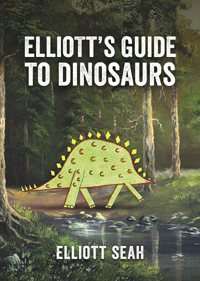| ________________
CM . . .
. Volume XXIII Number 9. . . .November 4, 2016
excerpt:
Originating as a class assignment, this guide was written when the author, a student in the gifted program at Marguerite Bourgeois Elementary School in Montreal, was only eight-years-old. Seah’s classes in paleontology, his personal research and his collaboration with graphic artist, Christine Cade, have resulted in this book which focuses on 13 dinosaur species and contains general information about the arrival of dinosaurs on Earth, their diet (indicated by tooth shape), defenses, appearance, reproduction, social groups, method of locomotion, and their eventual extinction. As readers navigate through facts about the Triassic, Jurassic and Cretaceous periods, they will be introduced to terms such as graviportal, cursorial, synapsid and diapsid. Text boxes, accompanied by drawings of each of the 13 specific dinosaur species, list, in point form, where and when the dinosaur lived, its length and weight, diet, method of locomotion and the name of a museum where readers can view an entire skeleton. Distinguishing features are also highlighted, one example of which is the incredible biting power of a tyrannosaurus rex (12,800-40,000 lbs. per square inch) compared to that of a human (a mere 120 lbs. per square inch) and a Nile crocodile (7,700 lbs. per square inch). In addition, there is very brief information about a paleontologist’s tools and the process by which dinosaur bones are extracted from an archaeological dig and transported to the lab for further analysis. This section could have been enhanced, not only with more photographs, but also with more details about what happens once the bones arrive at the lab and how the skeleton is reconstructed.
Recommended. Gail Hamilton is a former teacher-librarian in Winnipeg, MB.
To comment
on this title or this review, send mail to cm@umanitoba.ca.
Copyright © the Manitoba Library Association. Reproduction for personal
use is permitted only if this copyright notice is maintained. Any
other reproduction is prohibited without permission.
Next Review | Table of Contents For This Issue - November 4, 2016 |
